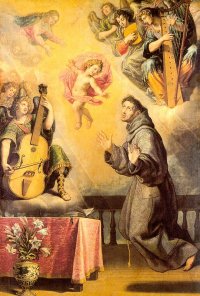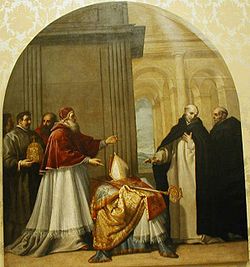
Vincenzo Carducci
Encyclopedia


Italy
Italy , officially the Italian Republic languages]] under the European Charter for Regional or Minority Languages. In each of these, Italy's official name is as follows:;;;;;;;;), is a unitary parliamentary republic in South-Central Europe. To the north it borders France, Switzerland, Austria and...
painter.
He was born in Florence
Florence
Florence is the capital city of the Italian region of Tuscany and of the province of Florence. It is the most populous city in Tuscany, with approximately 370,000 inhabitants, expanding to over 1.5 million in the metropolitan area....
, and was trained as a painter by his brother Bartolomeo, whom he followed to Madrid
Madrid
Madrid is the capital and largest city of Spain. The population of the city is roughly 3.3 million and the entire population of the Madrid metropolitan area is calculated to be 6.271 million. It is the third largest city in the European Union, after London and Berlin, and its metropolitan...
as a boy.
He Initially painted some works at Valladolid
Valladolid
Valladolid is a historic city and municipality in north-central Spain, situated at the confluence of the Pisuerga and Esgueva rivers, and located within three wine-making regions: Ribera del Duero, Rueda and Cigales...
and helped his brother in painting at the Escorial for Philip II of Spain
Philip II of Spain
Philip II was King of Spain, Portugal, Naples, Sicily, and, while married to Mary I, King of England and Ireland. He was lord of the Seventeen Provinces from 1556 until 1581, holding various titles for the individual territories such as duke or count....
. He returned to the court of Philip III
Philip III of Spain
Philip III , also known as Philip the Pious, was the King of Spain and King of Portugal and the Algarves, where he ruled as Philip II , from 1598 until his death...
in Madrid in 1606 and helped decorate the recently rebuilt Palacio del Pardo. While at work his brother died, and Vicente took his place. He painted there a history of Achilles. When finished, he was employed for four years by the monks of the Chartreuse of el Paular to decorate their monastery with 55 canvases of historical figures the great cloister. 27 represent the live of St. Bruno, 27 of martyrs.
He worked a great deal for the subsequent monarch, Philip IV
Philip IV of Spain
Philip IV was King of Spain between 1621 and 1665, sovereign of the Spanish Netherlands, and King of Portugal until 1640...
, and his best pictures are those he executed for him as decorations in the Prado. Examples of his work are preserved at Toledo
Toledo, Spain
Toledo's Alcázar became renowned in the 19th and 20th centuries as a military academy. At the outbreak of the Spanish Civil War in 1936 its garrison was famously besieged by Republican forces.-Economy:...
, Segovia
Segovia
Segovia is a city in Spain, the capital of Segovia Province in the autonomous community of Castile and León. It is situated north of Madrid, 30 minutes by high speed train. The municipality counts some 55,500 inhabitants.-Etymology:...
, and several other Spanish
Spain
Spain , officially the Kingdom of Spain languages]] under the European Charter for Regional or Minority Languages. In each of these, Spain's official name is as follows:;;;;;;), is a country and member state of the European Union located in southwestern Europe on the Iberian Peninsula...
cities. For many years he labored in Madrid as a teacher of his art, and among his pupils were Giovanni Ricci, Pedro Obregon, Vela
Vela
Vela may refer to:* Vela, a constellation * Vela Pulsar, a pulsar in the constellation of Vela* Project Vela, a system developed by the United States to monitor compliance with the Partial Test Ban Treaty...
, Francisco Collantes
Francisco Collantes
Francisco Collantes was a Spanish Baroque era painter.Collantes was born in Madrid but sought influence from Jusepe de Ribera and the Neapolitan School. He was also influenced by 16th century Venetian painters and was renowned for his landscapes and biblical scenes.-External links:*-References:...
, and other distinguished representatives of the Spanish school during the 17th century.
He also authored a treatise, De las Excelencias de la Pintura or Diálogos de la pintura, su defensa, origen, essencia, definición, modos, y differencias, published in 1633. Written in classical tradition as a dialogue between a master and an apprentice. Following strict piety of the Spanish realm, the text urges:
"Shame on me and all those who rash and impudent, and without meditation and without improving our souls, in this world set out to paint a portrait of the most Holy Queen of Angels, Mother of the Almighty, she who was full of grace, she who will be our means for gaining heaven...How well this was understood by that holy monastic painter Brother Juan Fesulano..(who) never started to paint without praying first..and (who) wept whenever he painted Christ on the Cross."
Carducci also assailed the verism of practiced by some such as Velázquez
Diego Velázquez
Diego Rodríguez de Silva y Velázquez was a Spanish painter who was the leading artist in the court of King Philip IV. He was an individualistic artist of the contemporary Baroque period, important as a portrait artist...
, and particularly was critical of Caravaggio
Caravaggio
Michelangelo Merisi da Caravaggio was an Italian artist active in Rome, Naples, Malta, and Sicily between 1593 and 1610. His paintings, which combine a realistic observation of the human state, both physical and emotional, with a dramatic use of lighting, had a formative influence on the Baroque...
and his followers, on whom he wrote:
"His new dish is cooked with condiments, with so much flavor, appetite, and relish that he has surpassed everybody with such choice tidbits and a license so great that I am afraid the others will suffer apoplexy in ther true principles, because most painters follow him as if they were famished. They do not stop to reflect of the fire of his talent which is so forceful, nor whether they are able to digest such an impetuous, unheard of, and incompatible technique, nor whether they possess Caravaggio's nimbleness of painting without preparation. Did anyone ever paint, and with so much success, as this monster of genius and talent, almost without rules, without theory, without learning and meditation, solely by the power of this genius and the model in front of him which he simply copied so admirably.? I heard a zealot of our profession say that the appearance of this man mean a foreboding of ruin and end of painting, and how at the close of this visible world the Antichrist, pretending to be the real Christ with false and strange miracles and monstrous deeds would carry with him to damnation a very large number of people moved by his works which seemed so admirable (although they were in themselves deceptive, false, and without truth or permanence).
"Thus this Anti-Michelangelo with his showy and external copying of nature his admirable technique and liveliness has been able to persuade such a large number of all kinds of people that his is good painting and that his theory and practice are right,that they have turned their backs on the true manner of perpetuating themselves and on true knowledge in this matter."
Carducci died in Madrid.
External links
- Bartolommeo and Vincenzo Carducci - Catholic Encyclopedia article

